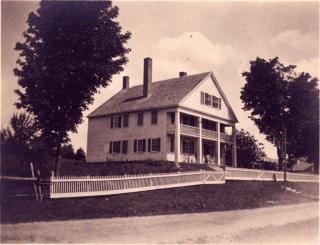The Nathan Morse House

This large house with its imposing portico with balcony across the front was built by Nathan Morse who carried on his shoe business in the shop immediately to the west (the present-day Historical Society Building). Nathan lived in Stoddard 1828 until 1854 when he died. Ellen, one of his eight children, lived on there for many years. Mr. and Mrs. Robert Webster owned the house in 1974.
The house has the distinction of having a large, sprung dance floor on the third floor with benches around the sides for those sitting out the dances in the 19th century.
The house is located between the Historical Society building and the White House (see White House) on Rt. 123 North near the Congregational Church.
Additions to Morse House page: Quoted from Bob and Joanne Webster in letter of Dec. 19, 2001, to the former webmaster, Jean Kelly:
"My wife and I lived in Stoddard only briefly (from 1973 to 1975), but we have many fond recollections of our experiences. We bought the "Loomis-Hadley" and "Nathan Morse" homes on which we did extensive renovation/restoration work. The Hadley place was our home for the brief period we lived in Stoddard. The Morse house was owned by Balcom Goodspeed at the time we moved to Stoddard. He had inherited it in the 1950’s from several aunts, one of whom was a descendent of Nathan Morse. At the time we purchased the house, the only "safe" entry was up a ladder to the 2nd floor balcony and through the door- the first floor had collapsed into the basement!"
"The house has a very unusual construction…it was built with no interior bearing walls nor interior posts to carry the load….Each floor of the house had several main timbers running the width of the house from side-to-side and these timbers supported each floor independently. Originally there had been quarried granite posts in the basement that supported these large timbers, but the soggy clay had undermined most of them and the timbers had rotted to a very hard core of about 4"-6" diameter (still very strong, but not strong enough!)"
"We had an expert in hydraulics come in and stabilize the fireplaces using wood cribbing. I then removed all the rest of the hanging (or fallen) material and numbered and removed all the floorboards (most were in condition to be reused when the subflooring was rebuilt.)…When we rebuilt the first floor, we had a new fireplace built and lined with the original brick to retain the original appearance as much as possible. Of course, we had no pictures of what the original rear fireplace was like, so we patterned it after a late 18th century house in Surry where we had lived one summer…."
"The interior walls were built with solid 5/4" rough planking set vertically, then each side of the planking had old hand-split pine lath with horsehair plaster applied (about ¾" of plaster!)…needless to say, those walls were HEAVY! When we reconstructed the flooring and underpinnings, we boxed in the fireplace supports and added many supports in the basement which were carried from the first to second and second to ballroom floors with some vertical posts we added in the hallways."
"The house was originally constructed in 1843 by Nathan Morse using much of the material from the old meeting house which stood up near where the new school is (old town center). The ballroom on the third floor is lined with old benches (pews?) which have leather hinges and came from the meetinghouse which also served as a church. Many of the timbers show notches intended for their original use in the meetinghouse. There is a wonderful poem in the Stoddard history about the old meeting house and the ending reflects on the Morse house having been built from those materials."

